Samsung Galaxy S6 And S6 Edge Review
The controversial new Samsung Galaxy S6 sheds its plastic construction, removable battery, expandable storage and environmental protection for slicker looks.
Why you can trust Tom's Hardware
Display And Audio
When we reviewed the Galaxy Note 4, we noted how Samsung continues to improve the quality of its SAMOLED displays with each generation. Indeed, our tests confirmed what our eyes saw: a terrific looking screen with accurate colors or bright, saturated colors depending on your display mode preference. For the Galaxy S6 and S6 edge, we’re happy to see this trend continue.
Like the Note 4, both versions of the S6 see improvements in display accuracy and resolution. Moving from the Galaxy S5’s 1080p resolution to the S6’s 1440p, while keeping the display size constant, increases pixel density by 33%. As many of our readers know, Samsung’s PenTile pixel layout contains fewer red and blue subpixels as compared to an RGB stripe LCD display, which caused some earlier PenTile based displays to appear grainy in certain conditions. The S6’s 1440p resolution nullifies this issue.
While both the S6 and S6 edge use Samsung made displays, their part numbers are different. This is hardly surprising, but we want to be clear that the S6 is not just using the S6 edge panel in a flat configuration. Thus, we expect to see some variation in the display measurements.
We’re using SpectraCal's CalMAN software and SpectraCal C6 colorimeter for display measurements. All of the charts below with a gray background were generated in CalMAN v5 Ultimate.


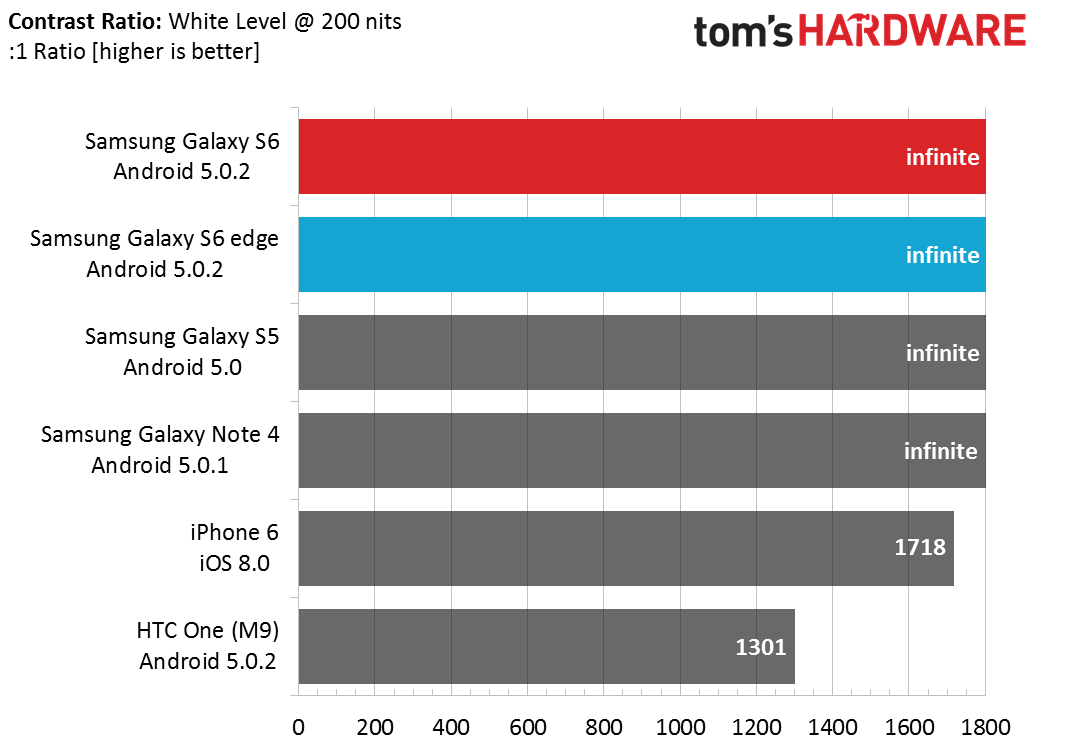
Full Brightness chart including values for APL=50 and auto-boost.
Since the brightness of an AMOLED display changes depending on what content is actually being displayed, we report brightness for two different conditions: APL=50% and APL=100% (APL stands for Average Picture Level). These APL values are a good upper and lower bound for what is seen during normal use.
All of Samsung’s SAMOLED displays, from the Galaxy S5 to the Galaxy Note 4 to both Galaxy S6s, achieve a max brightness of ~350 nits for an APL of 100%, a worst case condition. The new displays still fall shy of 400 nits—and the Galaxy S5—when the APL is adjusted to 50% as shown in the full brightness chart.
Get Tom's Hardware's best news and in-depth reviews, straight to your inbox.
With peak brightness falling between 360-370 nits for most scenarios, the S6 screens can be difficult to see in direct sunlight. For just this situation, Samsung provides a “boost” mode that kicks in if Auto brightness is selected and the ambient light exceeds a certain threshold. This “Auto boost” mode increases max brightness to between 575 and 670 nits depending on APL, making content viewable in the summer sun. It’s best suited to checking email or viewing a short video rather than reading a novel at the beach, however, since the screen consumes more power and will eventually overheat, causing brightness to fall back to normal levels.







Like other recent Samsung Galaxy products, the S6 and S6 edge have four different screen modes with different gamma curves, color gamuts, and color saturation levels: Basic, Cinema, Photo, and Adaptive display. According to Samsung, the Adaptive mode “optimizes” display parameters based on the app that's being used. It’s limited, however, to a handful of Samsung apps, making it impossible for us to test. Instead, we'll focus on the other three modes. For testing purposes, the "Auto adjust screen tone" setting, which automatically adjusts the screen luminance based on the content being displayed, is turned off.
In the Basic and Photo screen modes, the average gamma for both the S6 and S6 edge comes close to the ideal value of 2.2, improving upon the average gamma level of the S5 and Note 4. Gamma varies little across the full range of grayscale values in both Basic and Photo modes for either device.
Cinema mode for both devices, however, shows significant variation, peaking at ~2.6-2.7 at the low-end of the scale—leading to darker shadows and a loss of highlights—and ~1.2-1.3 near the white-end of the scale—resulting in a significant loss of shadow detail.
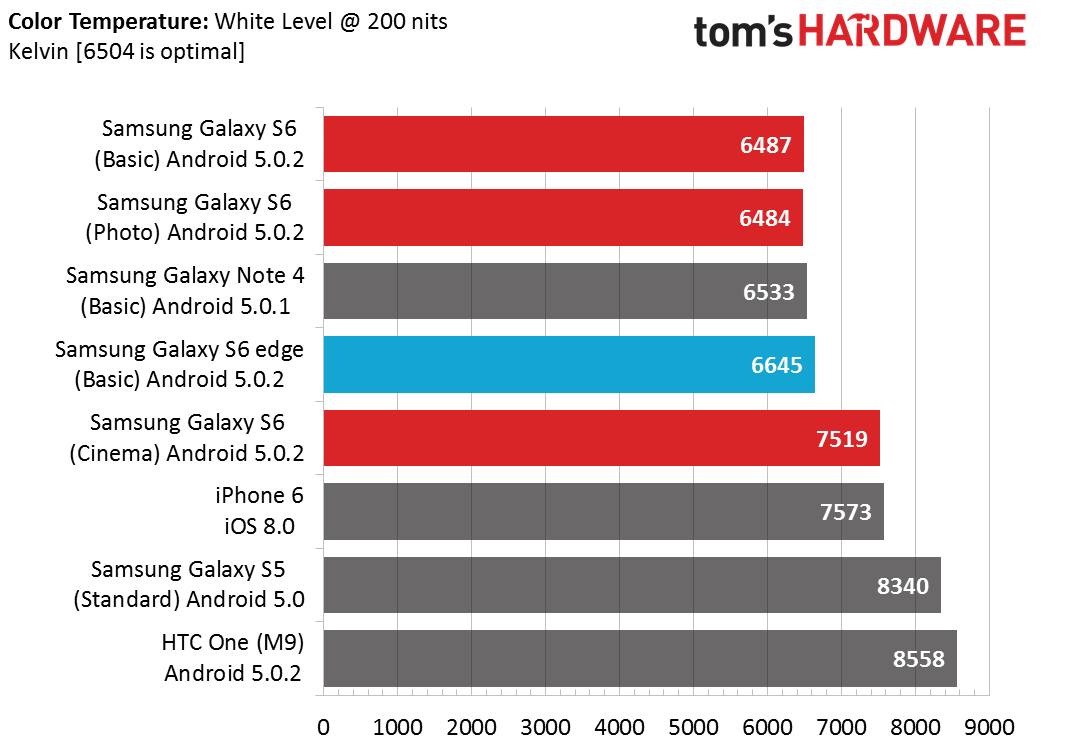






Once again, the Basic and Photo modes produce very accurate results for both devices, the S6 being slightly closer to the ideal value than the S6 edge. Cinema mode adopts a cooler color temperature, typical in mobile displays, but is still an improvement over the S5. In all three modes, there’s very little variation in color temperature across a full grayscale sweep (values close to 0% are not accurate).






Looking at the RGB balance across a range of grayscale values shows why the Basic and Photo modes get so close to the ideal color temperature. For the S6, no single primary color varies by more than ±3% for any grayscale level, skewing towards green. The S6 edge graphs look similar, with color variation up slightly to about ±4% and a small emphasis on blue instead of green.
Cinema mode displays far less balance, with an increasing disparity between blue and red approaching the white end of the spectrum. This leads to an obvious blue tint for lighter shades of gray and white.
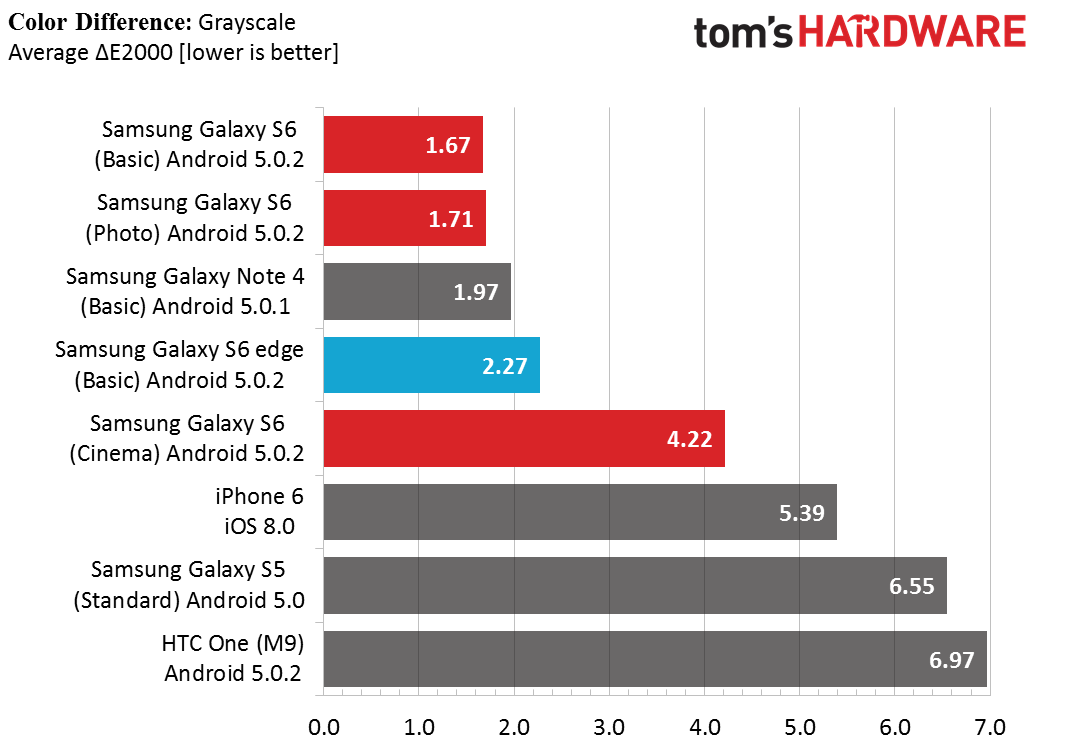



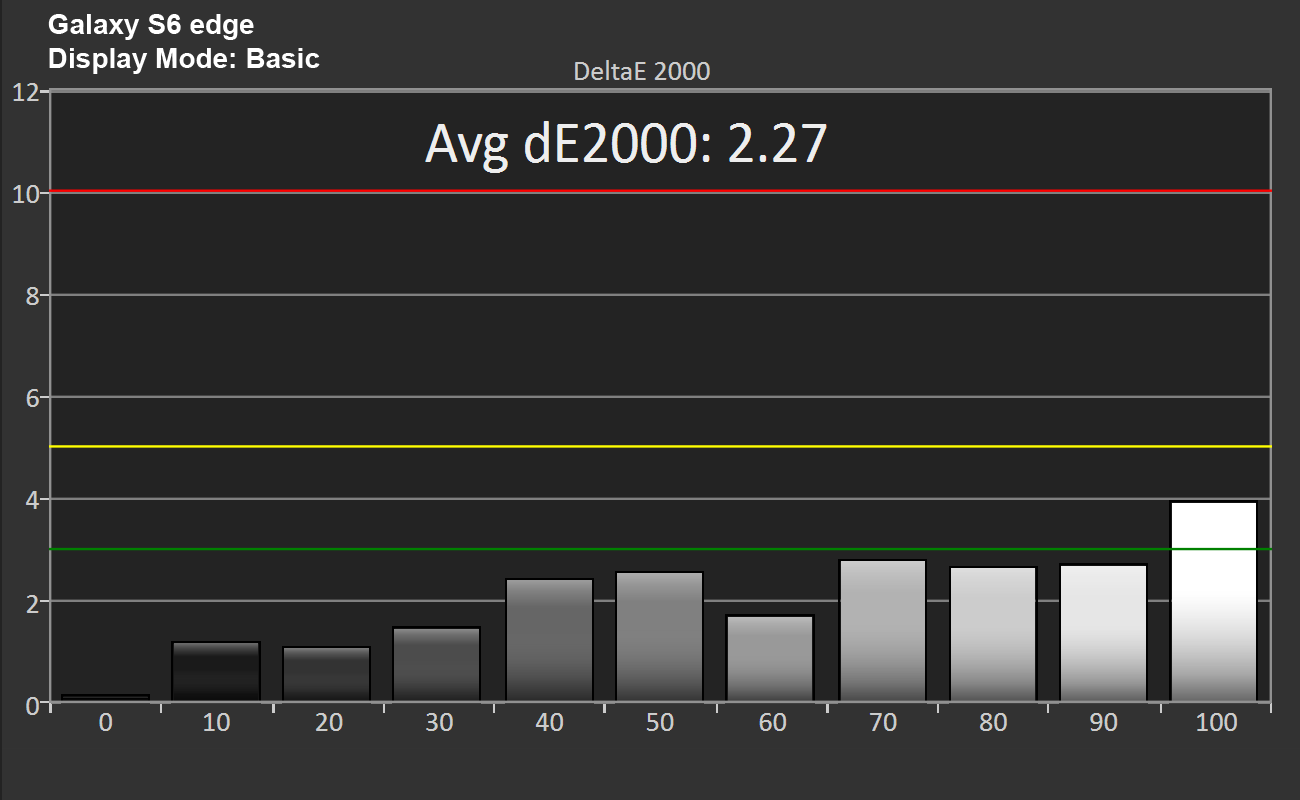


Grayscale accuracy in both the Basic and Photo modes is excellent, with average ΔE2000 for the S6 at 1.67 and never rising above three for any gray level. The S6 edge performs nearly as well, with error staying below three except at 100% white.
Grayscale error rises dramatically in Cinema mode due to the blue shift we saw in the RGB balance graphs above. At 100% white, error reaches a maximum of 7 for the S6 and almost 8.5 for the S6 edge, error values that are clearly visible to the naked eye.

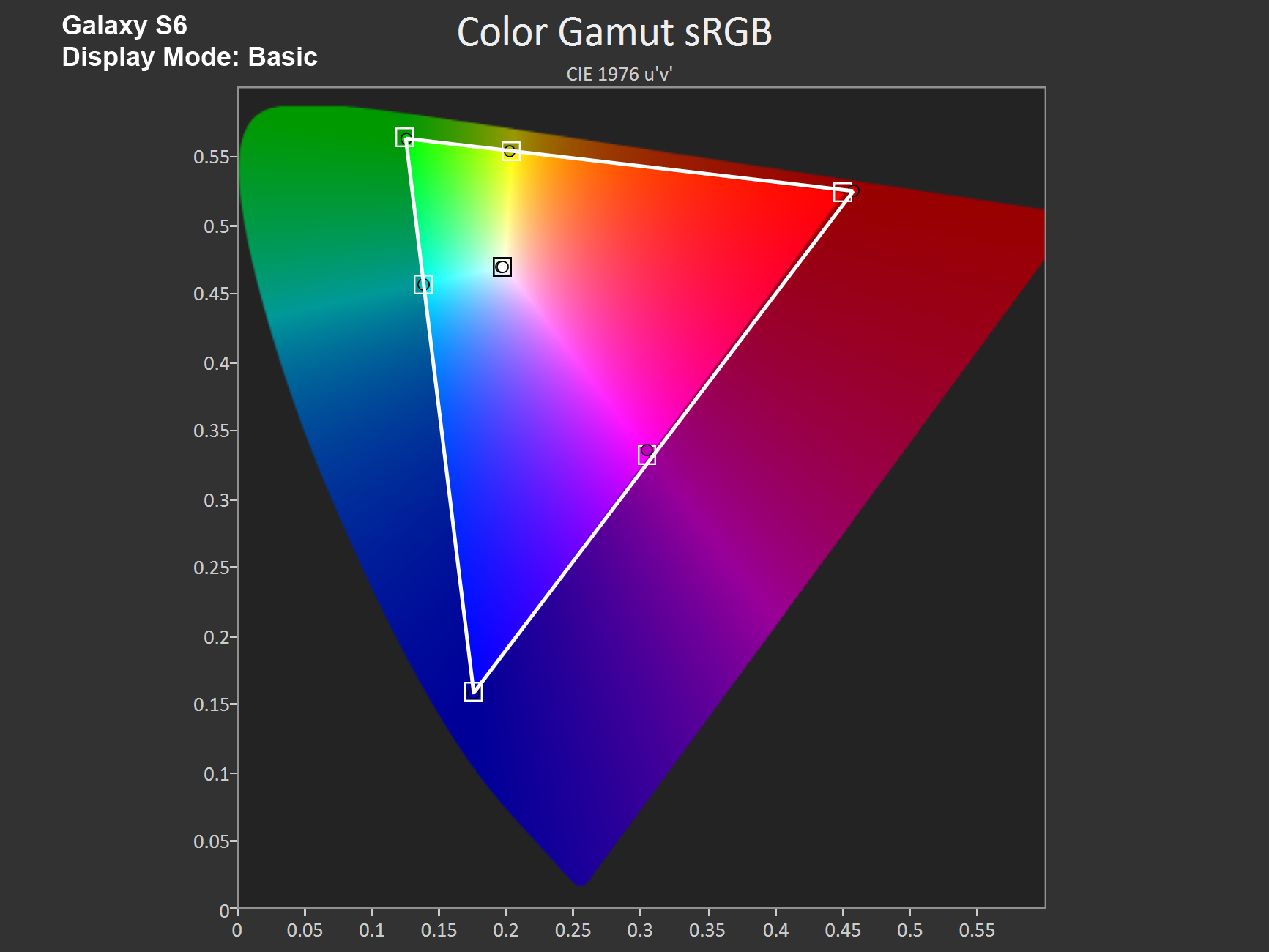


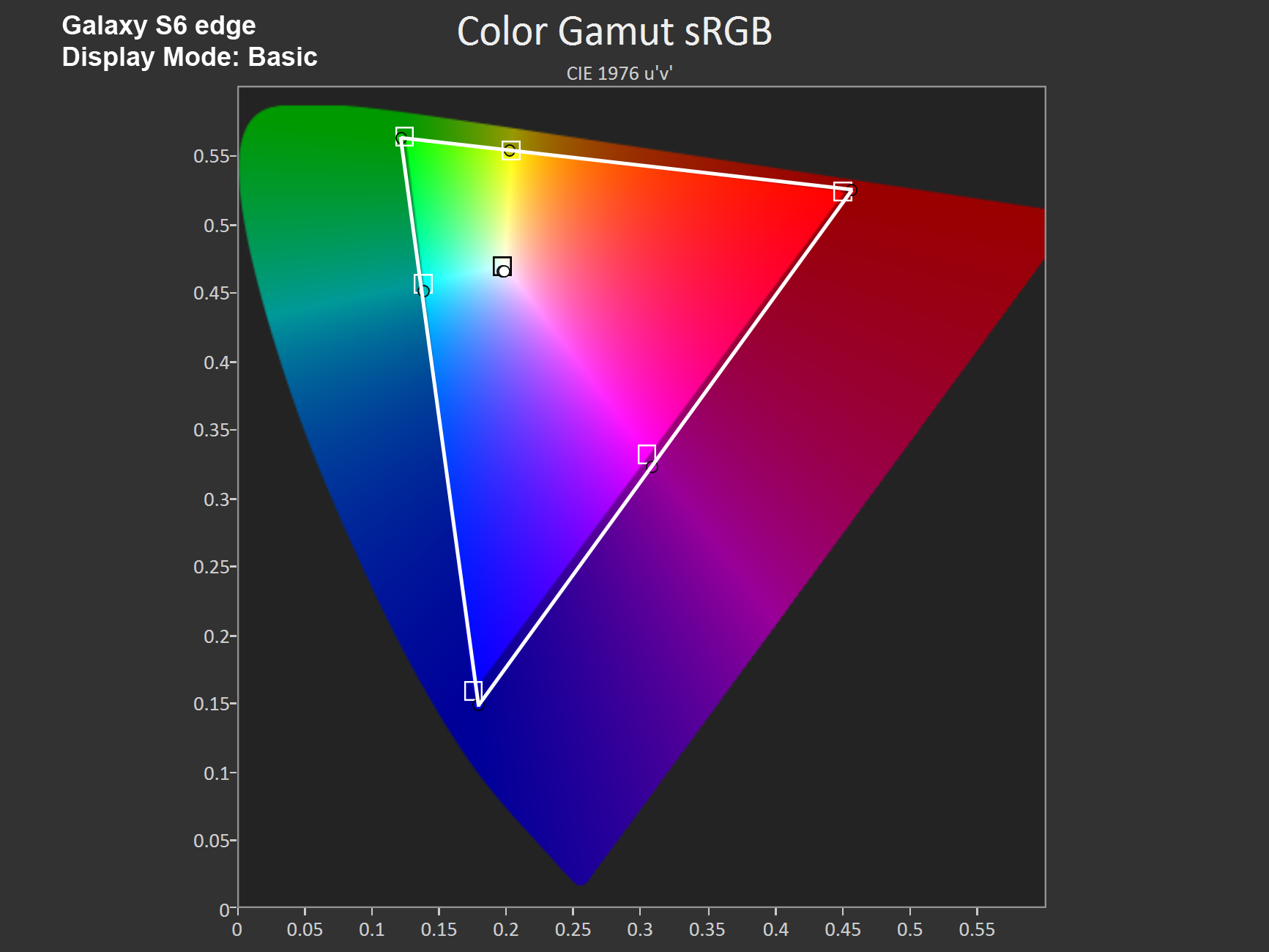


The S6 does an excellent job adhering to the sRGB color space in Basic mode. The same is mostly true for the S6 edge, except its blue vertex extends just beyond the sRGB triangle. Photo mode maintains the same red and blue vertex points as the Basic mode but extends green tones beyond sRGB. Cinema is a true wide-gamut mode covering about 130% of the sRGB color gamut. Currently, without OS support and color space aware apps, all content viewed on a mobile display will be in the sRGB color space. Viewing this content on a wide-gamut display results in over-saturated, neon-like colors that do not look natural.






In the color saturation sweep, the S6 in Basic mode performs very well, with the display hitting the target boxes at each color saturation level. There’s also no hint of color compression. The S6 edge in Basic mode does almost as well, but its extended gamut leads to oversaturated blues and magentas at each 20% saturation step.
In Photo mode, both devices show some color compression for red (the spacing between measurement points is less than 20%) and magenta tones skew towards red. Once again, the S6 does much better than the S6 edge representing blue tones.
Neither device does well in Cinema mode, where nearly all measured points appear oversaturated. Green is particularly bad, where a picture showing green grass at a 60% saturation for example, will be displayed as a pure 100% green in the sRGB color space. There’s also significant color compression, mostly a result of the extended color gamut. We also see that the white point (the black box in the middle) shifts towards blue.
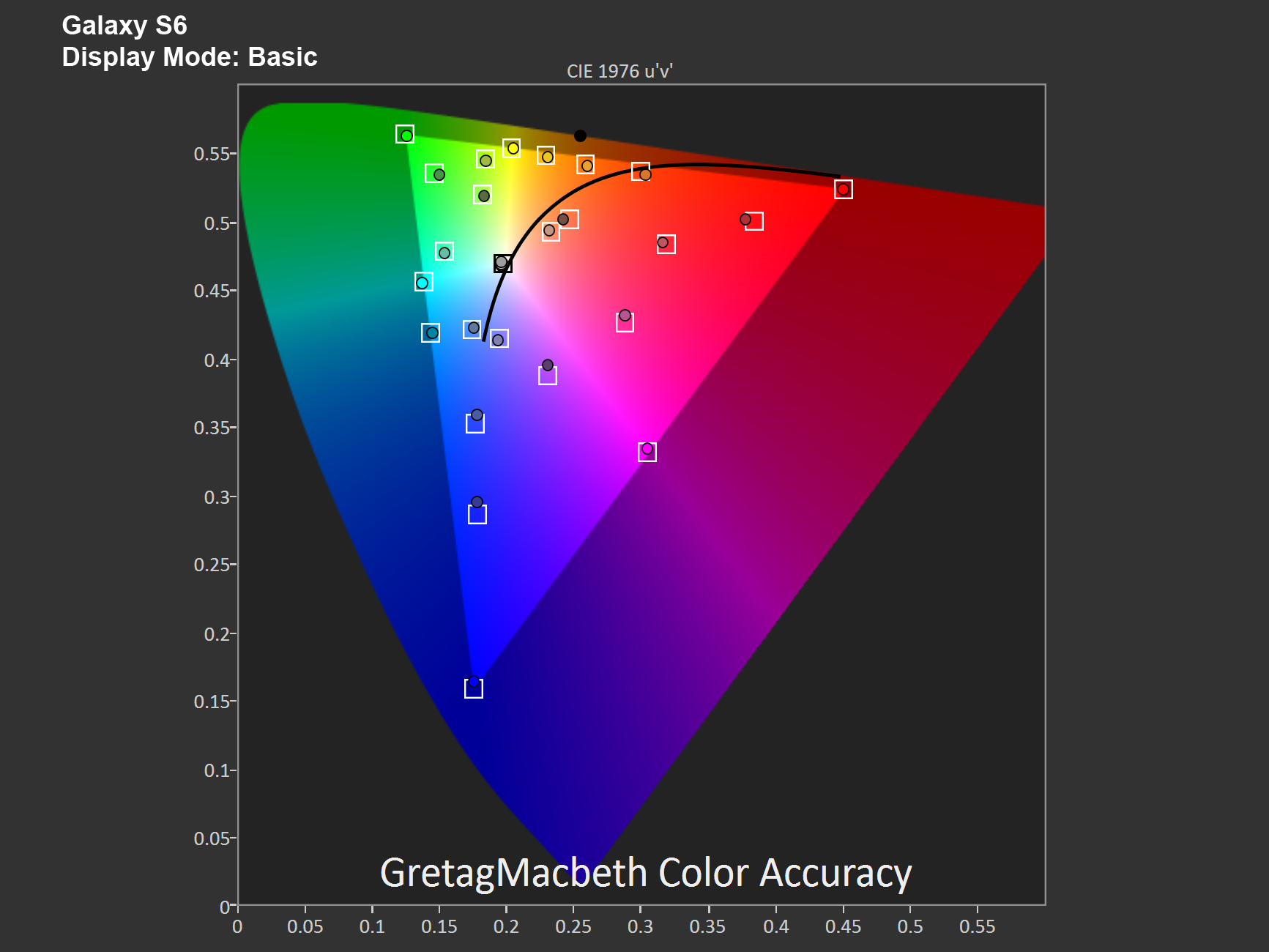












Color accuracy for the S6 in Basic mode is stellar. Most of the measured colors have an error below one, which is considered to be imperceptible. This is by far the most accurate display we’ve ever seen.
The S6 edge cannot match the accuracy of the S6 in Basic mode, although its results are still very good. Most colors show an error below two, with only a few colors such as cyan and orange going above three.
Color error climbs significantly in Photo mode, with the S6 edge again performing a bit worse than its flat-screened counterpart. Cinema mode is worse still, with very noticeable color deviations.






Full Size Images: [Color Palette: S6 Basic], [Color Palette: S6 Photo], [Color Palette: S6 Cinema], [Color Palette: S6 edge Basic], [Color Palette: S6 edge Photo], [Color Palette: S6 edge Cinema]
The color palettes above show the target color on the bottom versus the displayed color on the top and are another way of viewing color accuracy. For the Basic mode palettes, it’s very difficult to see any discernible difference between the target and displayed colors. In contrast, Cinema mode shows a clear deviation from each target color, clearly displaying the neon-like colors resulting from the wide-gamut support. There’s also an obvious blue tint to white and the various gray levels.
Whether you are a stickler for display accuracy or prefer more vibrant, saturated colors, Samsung’s display modes have you covered. Basic mode is a well-calibrated, proper sRGB mode that delivers accurate colors and grayscale values, while Cinema is a wide-gamut mode that produces more vivid colors and a cooler white point. Finally, Photo mode provides a reasonable compromise between these two extremes.
Viewing angles for both phones are excellent, with some color shifting only at extreme angles. The curved portions of the S6 edge’s display do exhibit some additional color shifting, although we do not find it distracting.
The display in the Galaxy S6 exceeds the already impressive display in the Galaxy Note 4 and simply looks amazing. The S6 edge’s curved screen also performs well, but cannot match the accuracy of the regular S6’s flat panel. Bottom line: the S6 and S6 edge have two of the best looking displays we have ever seen.
Audio Performance
The Galaxy S6 and S6 edge use the WM1840 audio codec from Wolfson Microelectronics (acquired by Cirrus Logic in 2014), a big change from Qualcomm’s WCD9320 audio codec used in the North American version of the Galaxy S5 (and also Sony’s Z3). Wolfson audio codecs have a reputation among audiophiles for their accurate sound, so this is not necessarily a bad move. This new audio chip is paired with a Maxim MAX98505 mono Class DG amplifier.
The position of the single external speaker also changes, moving from the back of the phone to a bottom, down-firing position. While not as efficient at delivering sound to your ears as a front-facing speaker, it’s still an improvement over the rear-firing speaker in the S5.
Volume for the external speaker ramps up smoothly until about the 90% mark where there’s a sudden, substantial jump in output. Overall, output volume is fairly low compared to most other phones; the iPhone 6 and Galaxy Note 4 are significantly louder, although the S6 exhibits less distortion at max volume than the Note 4.
With only a single external speaker, the soundstage is obviously limited and bass and treble are lacking. Compared to the iPhone 6, which also has a single, downward-firing speaker, the S6 sounds a bit flat and hollow when playing music. Vocals do not stand out and it’s difficult to pick out individual instruments. The iPhone 6 definitely has the better external speaker.
Plugging in a set of NAD VISO HP50 headphones and leaving the S6’s equalizer on the default “Normal” setting results in a fairly dull listening experience. Bass notes lacked punch and higher frequencies rolled off quickly. Female vocals lacked power and it was difficult to isolate specific instruments in certain tracks.
Fortunately, a few adjustments to the EQ—adding gain at 60Hz and 3kHz, with smaller boosts at 1kHz, 8kHz, and 16kHz—improves the sound significantly, virtually eliminating the issues heard at the default setting. However, output volume remained lower than the iPhone 6, which could cause issues for higher impedance headphones.
-
LordConrad Considering that Samsung's AMOLED screens have 30% fewer subpixels than other screen types, the 33% pixel increase in the S6 should make it roughly equal to the 1080p screens from other manufacturers.Reply
I'm tired of Samsung trying to claim a higher pixel count when they don't even use the same pixel structure as everyone else. -
blackmagnum If Samsung doesn't release the latest Galaxy product, what benchmark would Apple compare its new iPhone with then? ...can't be LG, Motorola or HTC.Reply -
zodiacfml Battery testing and results doesn't seem to give useful information. There should be a test for Wi-Fi and LTE testing just to keep it close real world usage.Reply
Unfortunately for 3D gaming, the S6 should remain plugged in. This reminds me of the also slim Nexus 5 with good performance in all corners but kills the battery too fast for use as portable gaming device. I guess that's where affordable external battery banks come in. -
Reaver192 I cannot figure out which camera is in my phone???? I did a search or the file“/sys/devices/virtual/camera/rear/rear_camtype” and got no results in the file manager app I downloaded. I have a verizon s6(non-edge) I don't know why I even care but I really want to know for some reason which sensor is in my phone????? Any advice/ : )Reply -
darkchazz ReplyConsidering that Samsung's AMOLED screens have 30% fewer subpixels than other screen types, the 33% pixel increase in the S6 should make it roughly equal to the 1080p screens from other manufacturers.
Exactly!
I'm tired of Samsung trying to claim a higher pixel count when they don't even use the same pixel structure as everyone else.
This reminds me of the nexus 6.
moto/google market its display as an incredibly sharp 1440p AMOLED panel, when in reality its total number of pixels is less than that of the nexus 5's 1080p LCD. -
alex davies ReplyI cannot figure out which camera is in my phone???? I did a search or the file“/sys/devices/virtual/camera/rear/rear_camtype” and got no results in the file manager app I downloaded. I have a verizon s6(non-edge) I don't know why I even care but I really want to know for some reason which sensor is in my phone????? Any advice/ : )
I just tried an alternate method on the Canadian S6 I have. Dial *#34971539# and in the menu that comes up hit the 'ISP VER CHECK' option and pop-up should come up with the sensor info. I am not sure if this works for the Verizon S6. -
MobileEditor <quote>I cannot figure out which camera is in my phone???? I did a search or the file“/sys/devices/virtual/camera/rear/rear_camtype” and got no results in the file manager app I downloaded.</quote>Reply
You can try the method Alex pointed out if you are still using the 5.0.2 firmware. This has been removed in the 5.1.1 update (at least for T-Mo). Some file manager apps may not let you see the root filesystem. You can try ES File Explorer as an alternative.
- Matt Humrick, Mobile Editor, Tom's Hardware -
MobileEditor ReplyI just got a Verizon Galaxy S6 a few days ago. So far the battery life has been so poor that I'm considering switching to something else. From what I've been reading, it appears that the S6 has issues with how much power it is trying to drive to the wireless connections at a given time, causing excess battery drain even with the screen off.
Matt, did you experience any unusual battery behavior during your testing?
I did not experience excessive power drain related to wireless activity, but I'm on a different network (T-Mo), in a different area, with a different usage pattern, and even a different baseband. So my experience won't mean much for you.
I did read an article (forget where) showing that the Samsung RF components used more power than the Qualcomm equivalents. Since the Verizon model uses the Qualcomm components, I'm surprised you're seeing excessive power use. Did you switch carriers when you got the S6?
This could be a software configuration issue. How many different apps do you have that get/receive info from the Internet? How aggressively are they fetching data? Setting email, facebook, twitter, etc. to fetch data every 30s, for example, would keep your radios powered up and drain the battery more quickly. Look at the following:
1) Settings->Data usage to see which apps are consuming the most data
2) Settings->Battery->Battery Usage to see what's using the most power
3) Settings->Battery->Detail to manage which apps are running and to check the "Abnormal Battery Usage" tab.
You might try disabling messaging/social media apps or at least dialing back the fetch policy to at least 30mins for each as a test.
- Matt Humrick, Mobile Editor, Tom's Hardware -
cknobman TouchWiz still a memory hogging piece of trash.Reply
And Samsung wonders why they keep losing market share, idiots. -
Vlad Rose Dumbest move they did was remove the microSD card expansion. At least their Note has it still. Once they remove it from the Note line as well, it will be the last Samsung I own. It was the biggest reason why I chose them over getting the same thing as my wife's iPhone. I gave up FaceTime so that I could have music for work (and use skype instead).Reply


